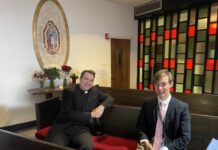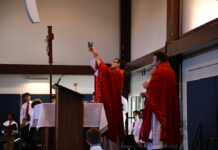Participating in Yom HaShoah at Congregation Beth Torah was a beautiful, humbling experience #RememberNeverForget #MenForAndWithOthers #AMDG pic.twitter.com/DVLam8DvqF
— JCP Campus Ministry (@JesuitDallasCM) April 23, 2017
2:00 a.m.–Placed atop the altar, the small flames of eleven yellow candles dance and flicker in the dim light of the synagogue. The subtle bursts of radiance from the candles illuminate the intricate golden Hebrew script festooning the walls of the worship space. At this early morning hour, two figures stand on the Bimah, or pulpit, looking out on to empty rows of benches, for the sanctuary is only inhabited by themselves and the quivering flames of the candles.
The two lone persons, in the synagogue hours before daybreak, are participating in the annual 24-hour Holocaust Remembrance Vigil at Congregation Beth Torah in Richardson, Texas. The ceremony consists of reading a list of Holocaust victims for a continuous 24-hour period, which coincides with the Jewish day of Holocaust remembrance, known as Yom HaShoa.
While the ceremony has been held at Congregation Beth Torah for the past sixteen years, only roughly one percent of the names of the six million Jewish victims have been read. Next to the altar an unfathomable amount of paper folders, filled with names, convey scope of the genocide to onlookers.
In addition to reading the names of the six million Jews who perished in the Holocaust, Congregation Beth Torah honors the additional five million handicapped, LGBTQ, Roma, and political dissidents who were likewise sentenced to death by the Nazis. In fact, the eleven remembrance candles in the sanctuary pay tribute to all eleven million humans who died at the hands of the Nazi’s ethnic cleansing policy.
On April 23, ten members of the Jesuit community attended the sixteenth annual Holocaust Remembrance Vigil and participated in the reading of names, marking the first occasion when non-Jews could engage in the reading.
“The privilege of entering into the sanctuary of a synagogue, and of reciting the names of victims was tremendous,” said Mr. Croteau, SJ. “I had taught my sophomores about the sufferings of the Holocaust through the book Man’s Search for Meaning, but to stand and read the names of person after person from Czechoslovakia who had perished in Auschwitz was a much deeper experience.”
The principle of reading the names individually was not only to communicate the scope of the massacre, but more importantly to begin to comprehend the loss of humanity, and assign a human identity to each of the eleven million.
Sophomore Brennan Louviere reflected, “Reading names at the Jewish synagogue had a deeper and more profound effect on me than I originally thought. I went in knowing the gravity of such a situation as serious as it was, but once on the podium, I realized that each of the names I read was a person– a person who had a story, an identity, a family, and a life.”
Another staggering fact presented to those who attended was the nearly 1.5 million children who died in the Holocaust, apparent in the myriad of young children on the reading lists.
“The purpose of this event last week was to join with our Jewish brothers and sisters to remember those whose lives were lost in the Holocaust, as well as the human and religious ties that unite us. The act of remembering particular victims one by one, by name, helps us to recall their dignity and to work on respecting that dignity in those with whom we live here and now,” added Mr. Croteau, SJ.
While each pair of students and faculty only read in five minute intervals, the personal impact was profound.
In his experience, freshman Javier Arroyo observed that, “The reading last Sunday was a really unique and special experience. It really gave me some perspective and really made me consider what it means to be a ‘man for others.’ Overall, I really think it was a life changing experience that helped me to grow, both in my relationship with my peers and my relationship with God.”
Attending the ceremony was a first for the Jesuit community, and ultimately furthered the inter-religious dialogue that bolsters both the school’s and each student’s relationship with the larger North Texas community.






